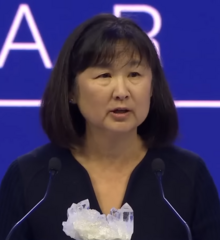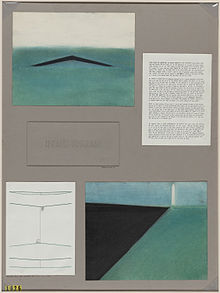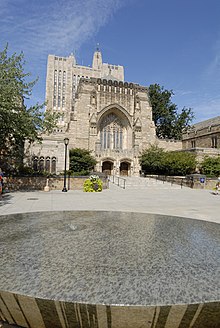
The Vietnam Veterans Memorial, commonly called the Vietnam Memorial, is a U.S. national memorial in Washington, D.C., honoring service members of the U.S. armed forces who served in the Vietnam War. The two-acre (8,100 m2) site is dominated by two black granite walls engraved with the names of those service members who died or remain missing as a result of their service in Vietnam and South East Asia during the war. The Memorial Wall was designed by American architect Maya Lin and is an example of minimalist architecture. The Wall, completed in 1982, has since been supplemented with the statue Three Soldiers in 1984 and the Vietnam Women's Memorial in 1993.

Three Soldiers is a bronze statue by Frederick Hart. Unveiled on Veterans Day, November 11, 1984, on the National Mall in Washington, D.C., it is part of the Vietnam Veterans Memorial commemorating the Vietnam War. It was the first representation of an African American on the National Mall.

The Wexner Center for the Arts is the Ohio State University's "multidisciplinary, international laboratory for the exploration and advancement of contemporary art."
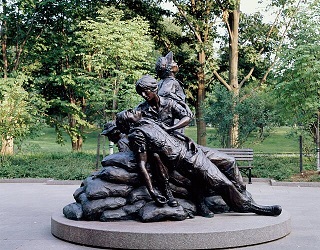
The Vietnam Women's Memorial is a memorial dedicated to the nurses and women of the United States who served in the Vietnam War. It depicts three uniformed women with a wounded male soldier to symbolize the support and caregiving roles that women played in the war as nurses and other specialists. It is part of the Vietnam Veterans Memorial and is located on the National Mall in Washington, D.C., a short distance south of the Wall and north of the Reflecting Pool. The statues are bronze and the base is made of granite. The United States Commission of Fine Arts and the National Capital Planning Commission selected Glenna Goodacre to sculpt the memorial after previously rejecting the idea for a memorial to women.

The Vietnam Veterans Memorial Fund, Inc. (VVMF), is the non-profit organization established on April 27, 1979, by Jan Scruggs, a former Army Infantry in Vietnam. Others veterans joined including, Jack Wheeler, and several other graduates of West Point to finance the construction of a memorial to those Americans who served or died during the Vietnam War. The memorial was not designed to make a political statement about the war itself. From this fund came the Vietnam Veterans Memorial, dedicated on Veterans Day, 1982, on the National Mall in Washington, D.C.
Alice Aycock is an American sculptor and installation artist. She was an early artist in the land art movement in the 1970s, and has created many large-scale metal sculptures around the world. Aycock's drawings and sculptures of architectural and mechanical fantasies combine logic, imagination, magical thinking and science.
Michael Robert Van Valkenburgh is an American landscape architect and educator. He has worked on a wide variety of projects in the United States, Canada, Korea, and France, including public parks, college campuses, sculpture gardens, city courtyards, corporate landscapes, private gardens, and urban master plans.
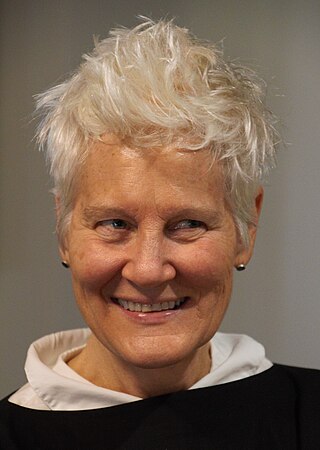
Ann Hamilton is an American visual artist who emerged in the early 1980s known for her large-scale multimedia installations. After receiving her BFA in textile design from the University of Kansas in 1979, she lived in Banff, Alberta, and Montreal, Quebec, Canada before deciding to pursue an MFA in sculpture at Yale in 1983. From 1985 to 1991, she taught on the faculty of the University of California at Santa Barbara. Since 2001, Hamilton has served on the faculty of the Department of Art at the Ohio State University. She was appointed a Distinguished University Professor in 2011.

Maya Lin: A Strong Clear Vision is a 1994 American documentary film made by Freida Lee Mock.
Chakaia Booker is an American sculptor known for creating monumental, abstract works for both the gallery and outdoor public spaces. Booker’s works are contained in more than 40 public collections and have been exhibited across the United States, Europe, Africa, and Asia. Booker was included in the 2000 Whitney Biennial, received a Guggenheim Fellowship in 2005, and an American Academy of Arts and Letters Award for Art in 2001. Booker has lived and worked in New York City’s East Village since the early 1980s and maintains a production studio in Allentown, Pennsylvania.
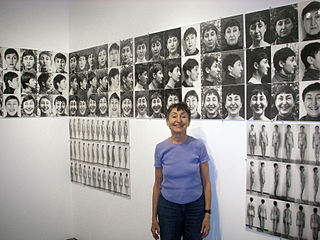
Athena Tacha, is a multimedia visual artist. She is best known for her work in the fields of environmental public sculpture and conceptual art. She also worked in a wide array of materials including stone, brick, steel, water, plants, and L.E.D. lighting. photography, film, and artists’ books. Tacha's work focused on personal narratives, and often plays with geometry and form.
Judy Pfaff is an American artist known mainly for installation art and sculptures, though she also produces paintings and prints. Pfaff has received numerous awards for her work, including a John D. and Catherine T. MacArthur Foundation Fellowship in 2004 and grants from the John Simon Guggenheim Memorial Foundation (1983) and the National Endowment for the Arts. Major exhibitions of her work have been held at the University of Wisconsin–Madison, the Denver Art Museum and Saint Louis Art Museum. In 2013 she was elected to the American Academy of Arts and Sciences. Video interviews can be found on Art 21, Miles McEnery Gallery, MoMa, Mount Holyoke College Art Museum and other sources.
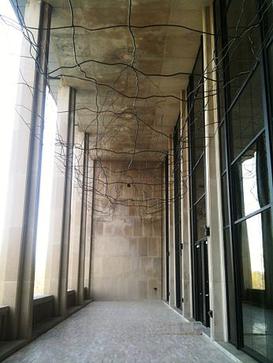
Above and Below is an installation by American artist Maya Lin, the designer of the Vietnam Veterans Memorial in Washington, D.C. It is on display at and owned by the Indianapolis Museum of Art located in Indianapolis, Indiana, United States. The artwork was inspired by underground water systems in Indiana.
Anti-monumentalism is a tendency in contemporary art that intentionally challenges every aspect of traditional public monuments. It has been defined as art designed "not to uphold but negate sacred values". Anti-monumentalism claims to deny the presence of any imposing, authoritative social force in public spaces.

John Angel was a British-born sculptor, architectural and ecclesiastical sculptor, medallist and lecturer. He emigrated to the United States where he created architectural sculpture. His work in the United Kingdom and the United States has been critically praised.

Mary Miss is an American artist and designer. Her work has crossed boundaries between architecture, landscape architecture, engineering and urban design. Her installations are collaborative in nature: she has worked with scientists, historians, designers, and public administrators. She is primarily interested in how to engage the public in decoding their surrounding environment.

Andrea Bowers, is an American artist working in a variety of media including video, drawing, and installation. Her work has been exhibited around the world, including museums and galleries in Germany, Greece, and Tokyo. Her work was included in the 2004 Whitney Biennial and 2008 California Biennial. She is on the graduate faculty at Otis College of Art and Design, and is Los Angeles–based.
Brooke Kamin Rapaport is Artistic Director and Martin Friedman Chief Curator at Madison Square Park Conservancy in New York City. She is responsible for the outdoor public sculpture program of commissioned work by contemporary artists. With an exhibition of Martin Puryear's work, Martin Puryear: Liberty/Libertà, Rapaport served as Commissioner and Curator of the United States Pavilion at the 2019 Venice Biennale. She frequently speaks on and moderates programs on contemporary art and issues in public art. Rapaport also writes for Sculpture magazine where she is a contributing editor. She lives in New York City.
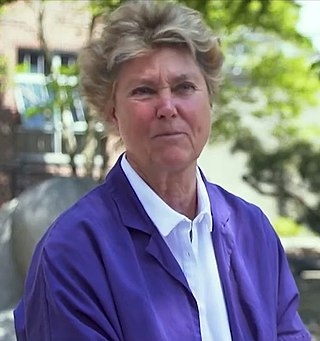
Edwina von Gal is an American landscape designer based in East Hampton, New York. Her firm, Edwina von Gal + Co founded in 1984, is based in East Hampton, NY and focuses on natural, sustainable designs. She has worked with numerous architects, designers and art world luminaries, among them Maya Lin, Annabelle Selldorf, Richard Gluckman, Richard Meier, Larry Gagosian, Cindy Sherman, David Maupin, Stefano Tonchi, Calvin Klein, and Richard Serra. She designed the park for Panama's Biomuseo, with Frank Gehry. Her approach emphasizes sustainability, natural landscapes, and the use of native species.

Elyn Zimmerman is an American sculptor known for her emphasis on large scale, site specific projects and environmental art. Along with these works, Zimmerman has exhibited drawings and photographs since graduating with an MFA in painting and photography at University of California, Los Angeles in 1972. Her teachers included Robert Heineken, Robert Irwin, and Richard Diebenkorn.
